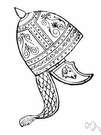casque
(redirected from casqued)Also found in: Thesaurus.
casque
(kăsk)n.
1. A piece of armor that covers the head; a helmet.
2. Zoology A helmetlike structure or protuberance.
[French, from Spanish casco; see cask.]
casqued (kăskt) adj.
American Heritage® Dictionary of the English Language, Fifth Edition. Copyright © 2016 by Houghton Mifflin Harcourt Publishing Company. Published by Houghton Mifflin Harcourt Publishing Company. All rights reserved.
casque
(kæsk)n
(Zoology) zoology a helmet or a helmet-like process or structure, as on the bill of most hornbills
[C17: from French, from Spanish casco; see cask]
casqued adj
Collins English Dictionary – Complete and Unabridged, 12th Edition 2014 © HarperCollins Publishers 1991, 1994, 1998, 2000, 2003, 2006, 2007, 2009, 2011, 2014
casque
(kæsk)n.
1. an armored headpiece, esp. a medieval helmet.
2. Zool. a process or formation resembling a helmet.
[1570–80; < Middle French < Sp casco helmet, head, earthen pot]
casqued, adj.
Random House Kernerman Webster's College Dictionary, © 2010 K Dictionaries Ltd. Copyright 2005, 1997, 1991 by Random House, Inc. All rights reserved.
ThesaurusAntonymsRelated WordsSynonymsLegend:
Switch to new thesaurus
| Noun | 1. |  casque - (15-16th century) any armor for the head; usually ornate without a visor casque - (15-16th century) any armor for the head; usually ornate without a visorbody armor, body armour, cataphract, coat of mail, suit of armor, suit of armour - armor that protects the wearer's whole body helmet - armor plate that protects the head |
Based on WordNet 3.0, Farlex clipart collection. © 2003-2012 Princeton University, Farlex Inc.
Translations